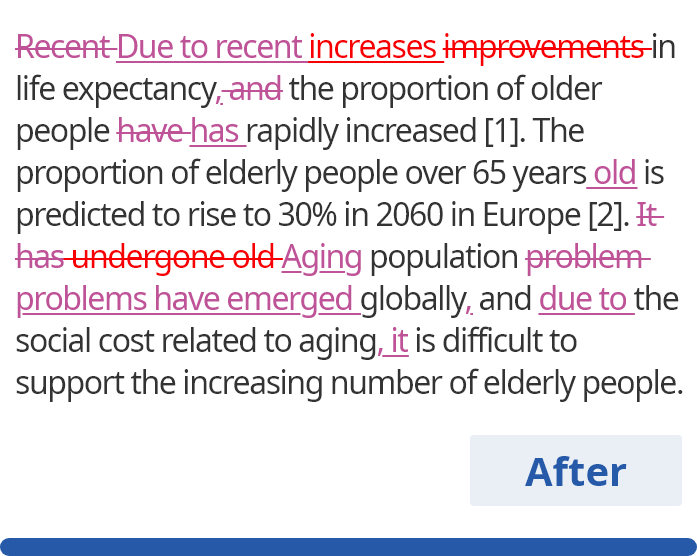How to Use Adjectives
An adjective is a word that provides information about the quality or quantity of a noun or pronoun. There are multiple types of adjectives, but they all serve the purpose of describing something. Articles are also classified as adjectives, as they are words that modify nouns.
- Example
- He has a cute puppy.
Wordvice services are helpful.
This movie is my favorite.
Types of adjectives
| Types of adjectives | What it does | Example |
|---|---|---|
| Descriptive Adjective |
Describes a noun or pronoun |
We saw a beautiful sunset. |
| Quantitative Adjective |
Provides information about the quantity of a noun or pronoun |
She brought three bags of chips. |
| Proper Adjective |
The adjective form of a proper noun |
Japanese animations are very popular. |
| Demonstrative Adjective |
Refers directly to something or someone |
This book is well-written. |
| Possessive Adjective |
Indicates possession |
Did you see my pen? |
| Interrogative Adjective |
Indicates a question |
Which song is your favorite? |
| Indefinite Adjective |
Provides unspecific information about a noun |
He found a few crystals in the cave. |
| Compound Adjective |
The combination of at least two words into a lexical unit that modifies a noun |
The composite is composed of fine-milled filaments. |
Table of Contents
Descriptive Adjectives
Descriptive adjectives describe nouns or pronouns. They provide additional information about a thing.
- Example
- The girl has a doll.
The girl has a pretty doll.
Here, the word “pretty” is a descriptive adjective. It describes the girl’s doll.
- Example
- We used a system to detect the response.
We used an adaptive system to detect the transient response.
Descriptive adjectives often convey essential information. “A system to detect the response” is vague and not particularly informative. “An adaptive system to detect the transient response” is much more specific and thus more informative.
Quantitative Adjectives
Quantitative adjectives describe the quantity of a noun. This quantity can be a precise number.
- Example
- Bacteria samples were cultivated for the experiment.
Three bacteria samples were cultivated for the experiment.
However, quantitative adjectives also include words such as “whole” or “complete.”
- Example
- A voltage drop can cause the instrument to malfunction.
A complete voltage drop can cause the instrument to malfunction.
Proper Adjectives
Proper adjectives are simply the adjective form of proper nouns. Proper nouns are specific names and are always capitalized. Nationalities, languages, institutions, and schools of thought all fall under proper nouns.
- Example
- Korean fried chicken is the tastiest.
- Example
- The admissions officer told me that Harvard classes are rigorous.
- Example
- Did you pick up the French textbook?
Korean, Harvard, and French are all proper nouns. In this context, however, they are being used as adjectives.
Demonstrative Adjectives
Demonstrative adjectives refer directly to a noun.
- Example
- This paper proposes a new algorithm that can detect seismic signals.
- Example
- Please be careful; those books are very old.
These adjectives must always precede the noun they describe.
- Incorrect
- Star that is the brightest in the sky.
- Correct
- That star is the brightest in the sky.
Commonly used demonstrative adjectives: that, this, those, these
Possessive Adjectives
Possessive adjectives indicate the person who owns or possesses a given noun.
- Example
- Our results revealed that a sudden drop in voltage can lead to enhanced performance.
- Example
- He was reading when his brother called him.
Like demonstrative adjectives, possessive adjectives must also always precede the noun they describe.
- Incorrect
- The results of study their were found to be inaccurate.
- Correct
- The results of their study were found to be inaccurate.
Commonly used possessive adjectives: my, your, his, her, our, their, its
Interrogative Adjectives
Interrogative adjectives indicate questions.
- Example
- Whose textbook is that?
- Example
- What is the motivation behind this study?
- Example
- Which sample is the most viable?
There are just three interrogative adjectives: what, which, whose
Indefinite Adjectives
Indefinite adjectives provide unspecific information about a noun.
- Example
- While it is possible to argue for some association between the subgroups, no concrete evidence was found.
In the sentence above, the author is not giving specific numbers or data on the association between the subgroups.
- Example
- Every sample was tested for contamination reduction.
- Example
- It was found that most of the subjects were not up to date on their vaccines.
Commonly used indefinite adjectives: some, every, each, most, several, many
Compound Adjectives
Compound adjectives are often compound words that describe nouns, and the separate words that make up the adjective are connected with a hyphen.
- Example
- We have developed a long-term solution to transient electromagnetic interference.
- Example
- The bitter old man was once a naïve, bright-eyed boy.
However, compound adjectives can also be a simple combination of words, typically blocked off with quotation marks. This is not often used in academic writing but is fairly common in colloquial contexts.
- Example
- She had her hair pulled back into her “I could not be bothered to care” bun.
Degree of Adjectives
The form of an adjective changes when it shows comparison. There are three degrees of comparison: positive, comparative, and superlative. Take for example the adjective “bright.”
- Positive
- He picked up the bright lamp.
- Comparative
- He picked up the brighter lamp.
- Superlative
- He picked up the brightest lamp.
Not all adjectives have comparative and superlative forms that are separate words. The comparative and superlative forms of many adjectives are created simply by adding the words “more” or “most.” One example of this is the adjective “brilliant.”
- Positive
- He is a brilliant student.
- Comparative
- He is a more brilliant student.
- Superlative
- He is the most brilliant student.
Using Adjectives in Academic Writing
In general, academic writing should be as concise as possible. This means that adjectives should be used only when they provide necessary information. Using too many adjectives can make a sentence wordy and difficult to follow.
- Example
- We developed a three-dimensional model of the protein gloverin.
Here, “three-dimensional” is a compound adjective that conveys essential information about the developed model. Omitting this adjective would remove important information.
- Example
- We developed a highly informative three-dimensional computer model of the antibacterial insect protein gloverin.
This is the same sentence but with additional adjectives. “Highly informative” and “computer” do not provide much more information about the developed model; they do little more than lengthen the sentence. The same goes for “antibacterial” and “insect”; they make the sentence unnecessarily long. The information provided by these two adjectives would be best conveyed by another clause.
- Example
- We developed a three-dimensional model of gloverin, an antibacterial insect protein that is isolated from silk moth pupae.












